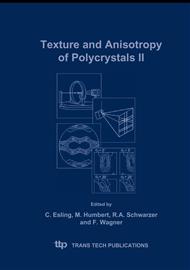[1]
K. Helming and U. Preckwinkel: Texture analysis with area detectors. Solid State Phenomena this volume.
DOI: 10.4028/www.scientific.net/ssp.105.71
Google Scholar
[2]
B. Schäfer and R.A. Schwarzer: SAD pole figures in transmission and reflection using a highgrade CCD camera as an area detector. Mater. Sci. Forum Vol. 273-275 (1998), pp.223-228.
DOI: 10.4028/www.scientific.net/msf.273-275.223
Google Scholar
[3]
M. Dahms and H.J. Bunge: The iterative series expansion method for quantitative texture analysis. I. General outline. J. Appl. Cryst. Vol. 22 (1989), pp.439-447.
DOI: 10.1107/s0021889889005261
Google Scholar
[4]
B. Schäfer: ODF computer program for high-resolution texture analysis with low-symmetry materials. Mater. Sci. Forum Vol. 273-275 (1998), pp.113-118.
DOI: 10.4028/www.scientific.net/msf.273-275.113
Google Scholar
[5]
L.E. Samuels: Metallographic Polishing by Mechanical Methods. 3rd Edition. American Society for Metals, Metals Park (1985).
Google Scholar
[6]
H. Krause and A.H. Demirci: Final texture of copper subjected to frictional stresses. Wear Vol. 37 (1976), pp.53-61.
DOI: 10.1016/0043-1648(76)90179-4
Google Scholar
[7]
H. Krause and A.H. Demirci: Texture changes in the running surface of face-centered cubic metals as the result of frictional stress. Wear Vol. 61 (1980), pp.325-332.
DOI: 10.1016/0043-1648(80)90295-1
Google Scholar
[8]
P.J. Regenet and H.P. Stüwe: Zur Entstehung von Oberflächentexturen beim Walzen kubisch flächenzentrierter Metalle. Z. Metallkunde Vol. 54 (1963), pp.273-278.
DOI: 10.1515/ijmr-1963-540504
Google Scholar
[9]
J. Gil-Sevillano, P. Van Houtte and E. Aernoudt: Die Deutung der Schertexturen mit Hilfe der Taylor-Analyse. Z. Metallkunde Vol. 66 (1975), pp.367-373.
DOI: 10.1515/ijmr-1975-660610
Google Scholar
[10]
P. Van Houtte: Simulation of the rolling and shear texture of brass by the Taylor theory adapted for mechanical twinning. Acta Metallurgica Vol. 26 (1978), pp.591-604.
DOI: 10.1016/0001-6160(78)90111-6
Google Scholar
[11]
V.I. Savchuk, I.A. Moroz, V.S. Ivaniji and A.V. Grishkevich: Textures forming in some steels machined by abrasives. Kristall und Technik Vol. 14 (1979), pp.471-474.
DOI: 10.1002/crat.19790140416
Google Scholar


